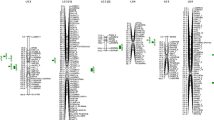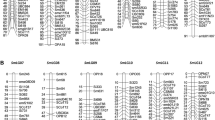Abstract
Improving seed related traits remains key objective in lentil breeding. In recent years, genomic resources have shown great promise to accelerate crop improvement. However, limited genomic resources in lentil greatly restrict the use of genomics assisted breeding. The present investigation aims to build an intraspecific genetic linkage map and identify the QTL associated with important seed relevant traits using 94 recombinant inbreds (WA 8649090 × Precoz). A total of 288 polymorphic DNA markers including simple sequence repeat (SSR), inter simple sequence repeat (ISSR) and random amplified polymorphic DNA (RAPD) were assayed on mapping population. The resultant genetic linkage map comprised 220 loci spanning 604.2 cM of the lentil genome, with average inter-marker distance of 2.74 cM. QTL mapping in this RIL population uncovered a total of 18 QTL encompassing nine major and nine minor QTL. All major QTL were detected for seed related traits viz., seed diameter (SD), seed thickness (ST), seed weight (SW) and seed plumpness (SP) across two locations. A considerable proportion of the phenotypic variation (PV) was accounted to these QTL. For instance, one major QTL on LG5 controlling SW (QTL 15) explained 50% PV in one location, while the same QTL accounted for 34.18% PV in other location. Importantly, the genomic region containing multiple QTL for different seed traits was mapped to a 17-cM region on LG5. The genomic region harbouring QTL for multiple traits opens up exciting opportunities for genomics assisted improvement of lentil.




Similar content being viewed by others
References
Abbo S, Ladizinsky G, Weeden NF (1991) Genetic-analysis and linkage study of seed weight in lentil. Euphytica 58:259–266
Akibode CS, Maredia M (2011) Global and regional trends in production, trade and consumption of food legume crops. Report submitted to the Standing Panel on Impact Assessment (SPIA) of the CGIAR Science Council, FAO, Rome
Arumuganathan K, Earle ED (1991) Nuclear DNA content of some important plant species. Plant Mol Biol Rep 9:208–218
Bohra A (2013) Emerging paradigms in genomics-based crop improvement. Sci World J 585467:17
Bohra A, Pandey MK, Jha UC, Singh B, Singh IP, Datta D, Chaturvedi SK, Nadarajan N, Varshney RK (2014) Genomics assisted breeding in four major pulse crops of developing countries: present status and prospects. Theor Appl Genet 127:1263–1291
Cubero JI, Pérez de la Vega M, Fratini R (2009) Origin, phylogeny, domestication and spread. In: Erskine W, Muehlbauer FJ, Sarker A, Sharma B (eds) The lentil: botany, production and use. CABI press, Wallingford, pp 13–33
Duran Y, Fratini R, Garcia P, Perez de la Vega M (2004) An inter subspecific genetic map of Lens. Theor Appl Genet 108:1265–1273
Eujayl I, Baum M, Powell W, Erskine W, Pehu E (1998) A genetic linkage map of Lentil (Lens sp.) based on RAPD and AFLP markers using recombinant inbred lines. Theor Appl Genet 97:83–89
FAOSTAT (2014) FAOSTAT database. http://faostat.fao.org/
Fedoruk MJ, Vandenberg A, Bett KE (2013) Quantitative trait loci analysis of seed quality characteristics in lentil using single nucleotide polymorphism markers. Plant Genome 6:37–39
Ford R, Pang ECK, Taylor PWJ (1999) Genetics of resistance to ascochyta blight (A. lentis) of lentil and the identification of closely linked RAPD markers. Theor Appl Genet 98:93–98
Fratini R, Duran Y, Garcia P, Perez de la Vega M (2007) Identification of quantitative trait loci (QTL) for plant structure, growth habit and yield in lentil. Span J Agric Res 5:348–356
Gupta PK, Varshney RK (2000) The development and use of microsatellite markers for genetics and plant breeding with emphasis on bread wheat. Euphytica 113:163–185
Gupta M, Verma B, Kumar N, Chahota RK, Rathour R, Sharma SK, Bhatia S, Sharma TR (2012) Construction of intersubspecific molecular genetic map of lentil based on ISSR, RAPD and SSR markers. J Genet 91:279–287
Hamwieh A, Udupa SM, Choumane W, Sarker A, Dreyer F, Jung C, Baum M (2005) A genetic linkage map of Lens sp. based on microsatellite and AFLP markers and the localization of Fusarium vascular wilt resistance. Theor Appl Genet 110:669–677
Hossain S, Ford R, McNeil D, Pittock C, Panozzo JF (2010) Inheritance of seed size in chickpea (Cicer arietinum L.) and identification of QTL based on 100-seed weight and seed size index. Aust J Crop Sci 4:125–134
Isemura T, Kaga A, Tabata S, Somta P, Srinives P, Himizu S, Jo P, Vaughan DA, Tomooka N (2012) Construction of a genetic linkage map and genetic analysis of domestication related traits in mung bean (Vigna radiata). PLoS ONE 7:e41304
Kahraman A, Kusmenoglub I, Aydinc N, Aydogan A, Erskine W, Muehlbauer FJ (2004) QTL mapping of winter hardiness genes in lentil. Crop Sci 44:13–22
Kaur S, Cogan NO, Stephens A, Noy D, Butsch M, Forster JW, Materne M (2013) EST-SNP discovery and dense genetic mapping in lentil (Lens culinaris Medik.) enable candidate gene selection for boron tolerance. Theor Appl Genet 127:703–713
Kosambi DD (1944) The estimation of map distances from recombination values. Ann Eugen 12:172–175
Phan HT, Ellwood SR, Hane JK, Ford R, Materne M, Oliver RP (2007) Extensive macrosynteny between Medicago truncatula and Lens culinari ssp. culinaris. Theor Appl Genet 114:549–558
Rubeena Ford R, Taylor PWJ (2003) Construction of an intraspecific linkage map of lentil, Lens culinaris ssp. culinaris. Theor Appl Genet 107:910–916
Saha GC, Sarker A, Chen W, Vandemark GJ, Muehlbauer FJ (2010) Identification of markers associated with genes for rust resistance in Lens culinaris Medik. Euphytica 175:261–265
Sato S, Isobe S, Asamizu E, Ohmido N, Kataoka R, Nakamura Y, Kaneko T, Sakurai N, Okumura K, Klimenko I, Sasamoto S, Wada T, Watanabe A, Kohara M, Fujishiro T, Tabata S (2005) Comprehensive structural analysis of the genome of red clover (Trifolium pratense L.). DNA Res 12:301–364
Sun YN, Pan JB, Shi XL, Du XY, Wu Q, Qi ZM, Jiang HW, Xin DW, Liu CY, Hu GH, Chen QS (2012) Multi-environment mapping and meta-analysis of 100-seed weight in soybean. Mol Biol Rep 39:9435–9443
Tahir M, Muehlbauer FJ (1995) Association of quantitative trait loci with isozyme markers in lentil (Lens culinaris L.). J Genet Breed 49:145–150
Tar’an B, Buchwaldt L, Tullu A, Banniza S, Warkentin TD, Vandenberg A (2003) Using molecular markers to pyramid genes for resistance to ascochyta blight and anthracnose in lentil (Lens culinaris Medik). Euphytica 134:223–230
Tullu A, Tar’an B, Breitkreutz C, Banniza S, Warkentin TD, Vandenberg A, Buchwaldt L (2006) A quantitative-trait locus for resistance to ascochyta blight (Ascochyta lentis) maps close to a gene for resistance to anthracnose (Colletotrichum truncatum) in lentil. Can J Plant Pathol 28:588–595
Tullu A, Tar’an B, Warkentin TD, Vandenburg A (2008) Construction of an intraspecific linkage map and QTL analysis for earliness and plant height in lentil. Crop Sci 48:2254–2264
Upadhyaya HD, Kumar S, Gowda CLL, Singh S (2006) Two major genes for seed size in chickpea (Cicer arietinum L.). Euphytica 147:311–315
Van Ooijen J (2006) JoinMap 4. Software for the calculation of genetic linkage maps in experimental populations, Kyazma BV, Wageningen
Varshney RK, Gaur PM, Chamarthi SK, Krishnamurthy L, Tripathi S, Kashiwagi J, Singh VK, Thudi M, Jaganathan D (2013) Fast-track introgression of “QTL-hotspot” for root traits and other drought tolerance trait in JG 11, an elite and leading variety of chickpea (Cicer arietinum L.). Plant. Genome 6:3
Varshney RK, Thudi M, Nayak SN, Gaur PM, Kashiwagi J, Krishnamurthy L, Jaganathan D, Koppolu J, Bohra A, Tripathi S, Rathore A, Jukanti AK, Jayalakshmi V, Vemula A, Singh SJ, Yasin M, Sheshshaye MS, Viswanatha KP (2014) Genetic dissection of drought tolerance in chickpea (Cicer arietinum L.). Theor Appl Genet 127:445–462
Verma P, Goyal R, Chahota RK, Sharma TR, Abdin MZ, Bhatia S (2015) Construction of a genetic linkage map and identification of QTLs for seed weight and seed size traits in lentil, Lens culinaris Medik. PLoS ONE 10:e0139666
Voorrips RE (2002) MapChart: software for the graphical presentation of linkage maps and QTLs. J Hered 93:77–78
Wang S, Basten CJ, Zeng ZB (2012) Windows QTL Cartographer 2.5. Department of Statistics, North Carolina State University, Raleigh, NC. http://statgen.ncsu.edu/qtlcart/WQTLCart.htm
Acknowledgements
RJ and TRS acknowledge financial support from the department of biotechnology (DBT), India. Special thanks are due to Dr. Fred Muehlbauer (Grain Legume Genetics & Physiology Research Unit, USDA-ARS, Washington State University, Pullman, USA) for providing experimental population.
Author information
Authors and Affiliations
Corresponding author
Ethics declarations
Conflict of interest
The authors declare that they have no conflict of interest.
Electronic supplementary material
Below is the link to the electronic supplementary material.
Rights and permissions
About this article
Cite this article
Jha, R., Bohra, A., Jha, U.C. et al. Analysis of an intraspecific RIL population uncovers genomic segments harbouring multiple QTL for seed relevant traits in lentil (Lens culinaris L.). Physiol Mol Biol Plants 23, 675–684 (2017). https://doi.org/10.1007/s12298-017-0438-7
Received:
Revised:
Accepted:
Published:
Issue Date:
DOI: https://doi.org/10.1007/s12298-017-0438-7




